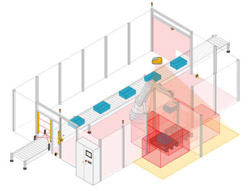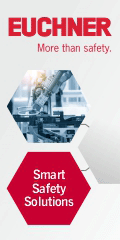
Posted to News on 24th Nov 2017, 14:46
Using 2D and 3D sensing technologies to safeguard machines
Compared with fixed and movable machine guards, some applications can benefit considerably from two- and three-dimensional safety sensors, with both optical and pressure-sensitive types of sensor having roles to play.

With area guarding of plant and machinery it is essential to reconcile safety, user-friendliness and productivity. Optical safeguards are useful for area guarding when people need to enter danger zones frequently or when material needs to be transported in or out. Light grids, laser scanners, camera systems and pressure-sensitive safety mats are often the best options for area guarding.
Light curtains
Transporting products in and out of a machine or process involves active intervention into the production process. In this application safety light grids are frequently specified because they safeguard people and capital assets. They are positioned at access points to danger zones - typically at infeed and outfeed conveyors - and register when persons or objects are inside the detection zone. If a light beam is broken, a safe shutdown command is triggered immediately, which halts the hazardous machine movements.
Depending on the requirement, light grids provide finger, hand or body protection in accordance with EN/IEC 61496-1/-2. They have short reaction times in the millisecond range, although these increase depending on the length and number of beams. In order to maintain the detection mode and still permit material to be fed through the light grid, advanced functions such as blanking, muting or cascading are necessary.
Laser scanners

The distance from the object is calculated by measuring the time difference between the light pulse being transmitted and then being reflected back (the 'time of flight' principle). In order to detect objects in different directions, the laser beam is cast via a rotating mirror. As a Category 3 safety product in accordance with IEC/EN 61496, safety laser scanners monitor two-dimensional areas.
Applications are varied, ranging from stationary area monitoring to automated guided vehicles (AGVs) and the safeguarding of robots. Above all, protection against encroachment behind the protected field has become more significant in recent years: often it is not enough to safeguard merely the access point to danger zones such as a robot cell (passage control); the space behind it also needs to be monitored because a machine restart needs to be prevented for as long as anyone is present in the danger zone. In contrast to key exchange systems, operation can be resumed seamlessly once the danger zone has been cleared.
3D monitoring

For safe zone monitoring, the sensing device is positioned above the area to be monitored. Warning and detection zones are defined along the envelope of the danger zone. The sensing device detects objects or persons that encroach into a warning or detection zone. The analysis unit receives and processes the image data from the sensing device and sends the results to the safety controller. As such it is the interface to the machine controller, ensuring that the machine movement is slowed down or stopped if warning and detection zones are violated.
The application areas for safe 3D camera systems are many and varied; in areas in which human and robot work hand-in-hand, 3D cameras for safe, physical access monitoring are an excellent choice.
Press brake safety

By constantly synchronising data between the press brake's CNC controller, the safe controller and the mobile camera system, the safe controller reliably calculates the current position of the upper tool above the plate. Depending on the detection zone range, even special-purpose presses such as tandem presses can be monitored.
The camera-based protection and measuring systems detect even small obstructions in the protected field between the transmitter and receiver. The light beams are transmitted from the transmitter to the receiver via a telecentric lens, which is positioned on the opposite end of the press brake. The detection zones are installed in front of, behind and below the tool. This prevents anyone from intervening dangerously during press braking - from any side.
Pressure-sensitive mats

Pressure-sensitive safety mats can be configured and connected to a safety-related control system so that plant or machinery is slowed or stopped when someone enters the danger zone (access protection) and also provide protection against encroachment behind the protected field. After all, it is essential to monitor not only access to the danger zone but also the zone behind it to prevent the plant or machine starting up unintentionally.
Pressure-sensitive safety mats are mainly used in complex applications where there are lots of obstacles and visibility is restricted, perhaps by dust or dirt. They are also suitable for protecting workspaces shared by humans and robots.
Conclusion
With safety-related equipment on machinery it is not just the individual components that matter but also the way in which they interact. If sensors and evaluation devices are sourced from a single manufacturer, then the interfaces between the components will be compatible. Pilz not only offers the necessary machinery safety products but also the services to support customers, such as training, safety concept design, engineering, programming and validation. For more information, go to www.pilz.co.uk.
Want the latest machine building news straight to your inbox? Become a MachineBuilding member for free today >>















